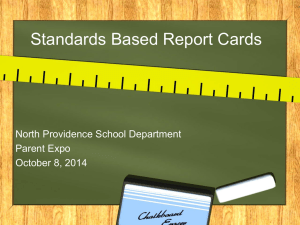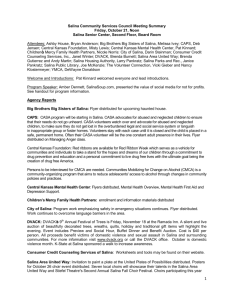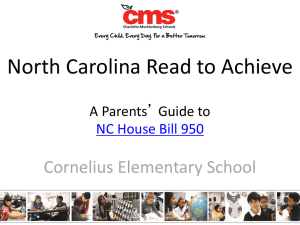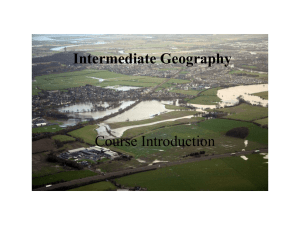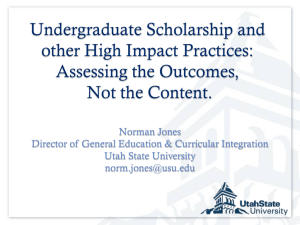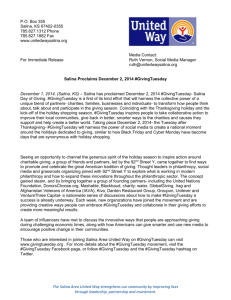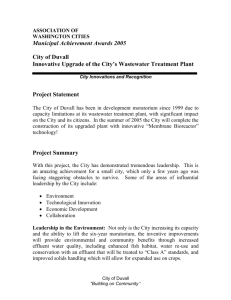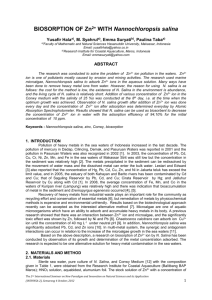to view the MACUL conference presentation on March 18th at 8
advertisement
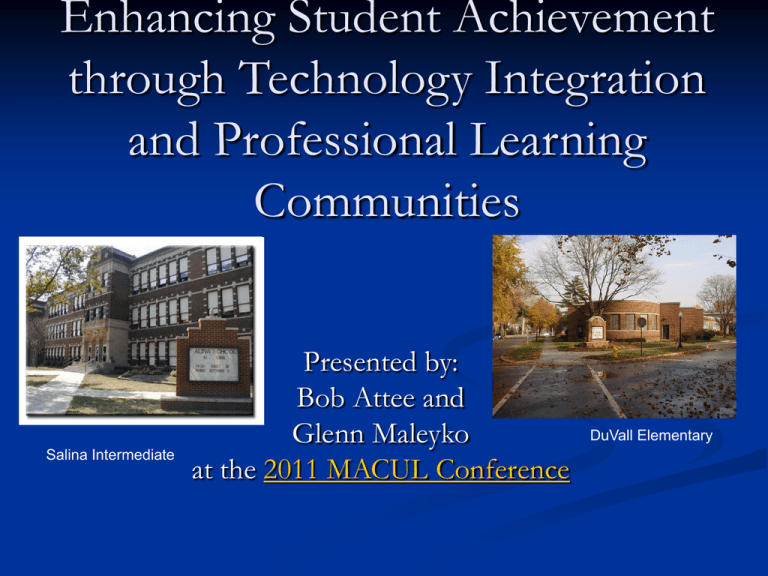
Enhancing Student Achievement through Technology Integration and Professional Learning Communities Salina Intermediate Presented by: Bob Attee and Glenn Maleyko at the 2011 MACUL Conference DuVall Elementary Presentation Goals: To explain how a Professional Learning Community model enhances our technology program. To describe how benchmark-aligned multimedia projects will increase student achievement levels. Presentation Overview Part 1: What Does Student Achievement Data Tell Us About PLC’s and Technology Integration? Part 2: Establishing a Technology Integrated PLC Part 3: Using Technology to Improve Student Achievement Levels Part 4: Lessons Learned The Current Economics of Education: Doing More with Less! With the ongoing reductions in funding from the federal and state government, Class size has increased General funds for supplies/ resources has decreased Team planning time has been eliminated in some districts How can teachers improve student achievement in the current economy? The Need for Change: “There is much uncertainty in our education system today. The continuation of public education as we know it is not guaranteed and maintaining status quo is not an option. Our education system has to change if the next generation is going to be successful in their world. All educators must play key roles in changing our schools.” – Bill Daggett, Model Schools Conference 2009 There is hope! Schools do make a difference! An analysis of research conducted over a thirtyfive year period demonstrates that schools that are highly effective produce results that almost entirely overcome the effects of student backgrounds. Robert Marzano, What Works in Schools, 2003. “All of us can consciously decide to leave behind a life of mediocrity and to live a life of greatness---at home, at work and in the community. No matter what our circumstances may be, such a decision can be made by everyone of us.” - Stephen Covey Covey, S. (2004). The 8th habit: From effectiveness to greatness. New York, NY: Franklin Covey Co. Pg. 29 A Tale of Two Schools Salina Intermediate: DuVall Elementary: 520 students in grades 4 – 8 We are located near the Ford Rouge Plant 23% Student Mobility Rate 71% of students are English Language Learners 99.8% of students qualify for free or reduced lunch 276 students in grades K-5 We are located near Greenfield Village and the Henry Ford Museum 9% students with disabilities 12% ELL students 24% Free and reduced lunch AYP has been met for several consecutive years. AYP has been met for several consecutive years. Salina Intermediate School MEAP Proficiency of All Students in Reading and Math from 2007 - 2009 Percentage of Students Meeting/ Exceeding State Standards Percentage of All 4th Grade Students Meeting/ Exceeding State Standards 100 80 60 40 91 89 67 56 63 Reading 56 20 0 2007 2008 Year 2009 Math Percentage of Students Meeting/ Exceeding State Standards Percentage of All 5th Grade Students Meeting/ Exceeding State Standards 100 80 71 60 40 53 59 63 71 Math 48 20 0 2007 2008 Year Reading 2009 Percentage of Students Meeting/ Exceeding State Standards Percentage of All 6th Grade Students Meeting/ Exceeding State Standards 100 80 60 40 65 70 65 74 53 Math 40 20 0 2007 Reading 2008 Year 2009 Percentage of Students Meeting/ Exceeding State Standards Percentage of All 7th Grade Students Meeting/ Exceeding State Standards 100 80 53 40 20 78 75 60 60 52 37 0 2007 2008 Year 2009 Reading Math Percentage of Students Meeting/ Exceeding State Standards Percentage of All 8th Grade Students Meeting/ Exceeding State Standards 100 80 60 40 72 62 74 56 49 Math 40 20 0 2007 2008 Year Reading 2009 Percent of Non ELL Students meeting State Proficiency Standards in 2009 - 2010 Subject Grade Reading 4 Reading Salina Intermediate District State 75 87 85 5 93 90 86 Reading 6 90 92 88 Reading 7 94 88 83 Reading 8 95 91 84 Percent of Non ELL Students meeting State Proficiency Standards in 2009 - 2010 Subject Grade Salina Intermediate Math 4 96 96 93 Math 5 91 88 80 Math 6 93 91 83 Math 7 94 91 83 Math 8 93 83 71 District State Percent of ELL Students meeting State Proficiency Standards in 2009 - 2010 Subject Grade Salina Intermediate District State Reading 4 40 55 64 Reading 5 35 42 62 Reading 6 47 55 70 Reading 7 24 38 54 Reading 8 50 51 61 Percent of ELL Students meeting State Proficiency Standards in 2009 - 2010 Subject Grade Salina Intermediate District State Math 4 88 92 87 Math 5 55 59 68 Math 6 62 61 69 Math 7 67 64 66 Math 8 58 51 50 How can we improve student achievement in traditional classes? In order to continue to improve student achievement levels, schools must have a cultural shift. Cultural Shifts: Becoming a Professional Learning Community “To put it as succinctly as possible, if you want to change and improve the climate and outcomes of schooling both for students and teachers, there are features of the school culture that have to be changed, and if they are not changed your wellintentioned efforts will be defeated” Seymour Sarason: Taken From Robert Eaker PLC presentation. A Traditional School Focuses on Teaching and a Professional Learning Community Focuses on Student Learning. Cultural Shift Traditional School Professional Learning Community Teacher Isolation Collaboration Decisions about improvement are opinion based. Decisions are researched based with collaborative teams seeking out best practices. When students don’t learn not systematic response. Systematic response as to how the school responds when students don’t learn. Administrators are viewed a leaders and teachers as followers. Administrators are leaders of leaders teachers are transformational leaders. Decisions about improvement are opinion based. Decisions are researched based with collaborative teams seeking out best practices. School Leadership is essential to change because it influences: A clear mission and goals The climate of school and climate of classrooms The attitudes of teachers The classroom practices of teachers The organization of curriculum and instruction Student opportunities to learn Marzano, Waters, McNulty: School Leadership that Works: From Research to Results p.5 Visionary leaders Effective visions help individuals understand that they are part of a larger world and also reassure them of their individual importance to the organization. Reeves, Douglas (2006). The learning Leader. “People want to be part of something larger than themselves. They want to be part of something they’re really proud of, that they’ll fight for, sacrifice for , trust.” — Howard Schultz DuVall Vision We see a DuVall Community that supports and builds on the strengths of each student, uses instructional best practices, inspires students to think critically and creatively in school and community. We see an educational partnership in which DuVall staff, families, and members of the community faithfully share the responsibility of educating each student in an atmosphere of trust and mutual respect. We see a continually changing teaching and learning environment that uses technology and research based best practices as the focal point for developing and implementing sound educational programs and instructional practices. We see a school community that encourages and insists its students achieve beyond GLCE’S. We see a school community that respects, appreciates, and celebrates our similarities and differences. We see a school community that embraces the Core Values. Salina Intermediate Mission The mission of Salina Intermediate School is to increase academic achievement by implementing and evaluating a technology integrated comprehensive curriculum which enables students to become literate problem-solving critical thinkers. We have high expectations for all students, and provide a safe and nurturing environment collaboratively with parents and community to ensure that all students become responsible, productive citizens. After developing a common vision and mission, it is critical to find time for collaboration and professional development (capacity building). Team Collaboration We can achieve our fundamental purpose of high levels of learning for all students only if we work together. We cultivate this collaborative culture through the development of high performing teams. Dufour & Eaker Finding Time for Professional Development Administrative support with scheduling Before and after school opportunities District Release time (late start) Substitutes to release teachers. Staff meetings Team meetings / collaboration (PLC) Assembly Release Time Administrative Visitations Conferences or workshops On-line professional development Team Collaboration Effective collaborative teams share knowledge, define learning standards, agree on pacing, build knowledge of best practice, and focus on issues that MOST impact student achievement. Team Collaboration and the 3 Essential Questions 1. What is it that we want children to Learn? 2. How will we know when they have learned it? 3. How will we respond when they don’t learn and/or how will we respond when they have learned? The most effective collaborative teams Focus on learning rather than teaching. If teams do not focus on issues and questions that most impact student achievement, they become “coblaboration” teams. Dufour & Eaker 2002 Advantages of collaborative teams: provide support for new teachers promote confidence among staff members allow teachers to work together to find quality solutions provide opportunities for sharing ideas, materials, and methods for better teaching enhance student achievement Important Team Components Three important components keep the team focus and help to subdue the resistors 1. The development of Team Norms 2. The development of Team Goals 3. Sustaining Good team leadership. In order to focus on school improvement, we must use SMART GOALS: Strategic and Specific Measurable Attainable Results oriented Time-bound. Salina Intermediate co-teaching model Through the PLC Model all of the core teachers collaborate In the Middle School 6th through 8th grade the Language Arts and Mathematics teachers co-teach Elementary 4th & 5th Grade teachers coteach in Mathematics & Language Arts and other core areas Using SuccessMaker in the Language Arts Lab Students are enrolled in a Language Arts Lab for one hour in lieu of one of their elective classes. Tracking Progress in the Language Arts Lab Using Technology in the Newcomer Center The Salina Model for Customizing Technology Based On Building Needs The process of customizing technology according to needs of the curriculum and buildings is as follows: A. Create a technology committee (building level). B. Identify benchmarks that require technology support. C. Attend conferences to learn about software and advances in technology D. Identify Software and Hardware needed. E. Make sure that the technology of interest makes the maximum use of the current technology. F. Training must accompany the acquisition of a new technology item. Technology Tools that can assist with Professional Learning Communities: Curriculum Crafter Identify Grade Level Content Expectations Align curriculum between grade levels Develop vocabulary lists and unit resources (links) Google Docs Conduct staff surveys Collaborate on presentations using the Internet Share and edit data Research & Data There is an enormous amount of data supporting technology integration in the classroom. International Society of Technology Education (ISTE) Standards National Education Association NEA Michigan Association for Computer Users in Learning (MACUL) USA Today: Teens use of cell phones in class Store information to look at during a test - 26% Text friends answers - 25% Search web for answers – 20% Take photo of test and send to friends -17% (USA Today: June 18, 2009) Effective Teachers Effective teachers have a classroom that is structured and organized and CONSISTENT in how the classroom is run. Harry Wong, 2009 Model Schools Conference Salina Technology Data projector, Document camera and Promethean Board in most of the core classrooms. Full wireless connectivity 8 mobile wireless labs Community Center with Technology access A media broadcast studio with a green screen for video production Multimedia software applications Activote systems. Multimedia Project Development 1. Begin with the end in mind – focus on related benchmarks/ GLCE’s 2. What is it that I REALLY want students to walk away with knowing ? – A major understanding defines what is essential 3. What am I looking for ? – in order to assess student achievement, determine what mastery of the benchmark/ GLCE will look like. ASSESSMENT METHOD TARGET TO BE ASSESSED SELECTED RESPONSE ESSAY PERFORMANCE ASSESSMENT KNOWLEDGE Multiple choice, true/false, matching, and fill-in can sample mastery of elements of knowledge Essay exercises can tap Understanding of relationships among elements of knowledge Not a good choice for this target REASONING Can assess understanding of basic patterns of reasoning Written descriptions of complex problem solutions can provide a window into reasoning proficiency Can watch students solve some problems and infer about reasoning proficiency PERFORMANCE SKILLS Can assess mastery of the prerequisites of skillful performance, but cannot tap the skill itself-not a good choice for this target Can assess mastery of the prerequisites of skillful performance, but cannot tap the skill itself-not a good choice for this target PRODUCTS Can assess mastery of prerequisite to the ability to create quality products, but cannot assess the quality of products themselves-not a choice Can assess mastery of knowledge prerequisite to the ability to create quality products, but cannot assess the quality of products themselves-not a good choice PERSONAL COMMUNICATION Can ask questions, evaluate answers and infer masterybut a time-consuming option Can ask student to "think aloud" or can ask follow-up questions to probe reasoning Strong match when skill is oral communication proficiency; Can observe and evaluate also can assess mastery of skills as they are being performed knowledge prerequisite to skillful performance A strong match; we can assess: (a) proficiency in carrying out steps in product development, and (b) attributes of the product itself Can probe procedural knowledge and knowledge of attributes of quality products - but not product quality Developed by Rick Stiggins Multimedia Project Development Discuss with your team how you can work together to enhance the curriculum between the content areas. When would it be better to teach a unit - ex. Science and social studies are both covering environmental problems in April; Science and math are covering charts and graphs in October. Designing Projects that improve student achievement : 4. Select the most appropriate technology based instructional materials. 5. Plan for it! – make lesson plans that include time for introducing the material, allowing students time to work on the project(s), making time available for presentations, and allowing for time to debrief! WE LEARN 10% OF WHAT WE READ 20% OF WHAT WE HEAR 30% OF WHAT WE SEE 50% OF WHAT WE HEAR AND SEE 70% OF WHAT IS DISCUSSED WITH OTHERS 80% OF WHAT WE EXPERIENCE PERSONALLY 95% OF WHAT WE TEACH SOMEONE ELSE W. M. Glasser Making instruction meaningful Students will be motivated by content that is rigorous and relevant. For content to be relevant, students must believe that the topic/content is important in their lives. For content to be rigorous, it must be challenging – not too difficult or easy to learn. Product Assessments Help students to rethink, use, and extend what they have learned. (Carol Tomlinson, 2001) Can be differentiated for students’ interest, learning styles, and readiness levels. Give the students scenarios (case studies) that allow them to make connections between curriculum topics and apply the content to their daily lives or future careers. Different ways to find out what students understand Present a news report Write and perform a rap Create (diagram) a model Conduct a discussion Make an editorial video Design a game Make a webquest Make a cartoon/comic Create a flowchart Develop an exhibit Keep a journal log Develop a learning center Use notecards with short questions Lessons Learned We are facing changing times in the world economy and with new advances in technology. Collaboration with colleagues can help to better use available technology resources in the school and make connections to other curriculum areas. The curriculum must be rigorous and relevant for students. Sample Project Ideas Other Project Ideas: Case Studies: Wolves Exotic Species Genetic Engineering Fossils Videos: Hillary Potter (writing a sequel to a book) Blogs: iblog


